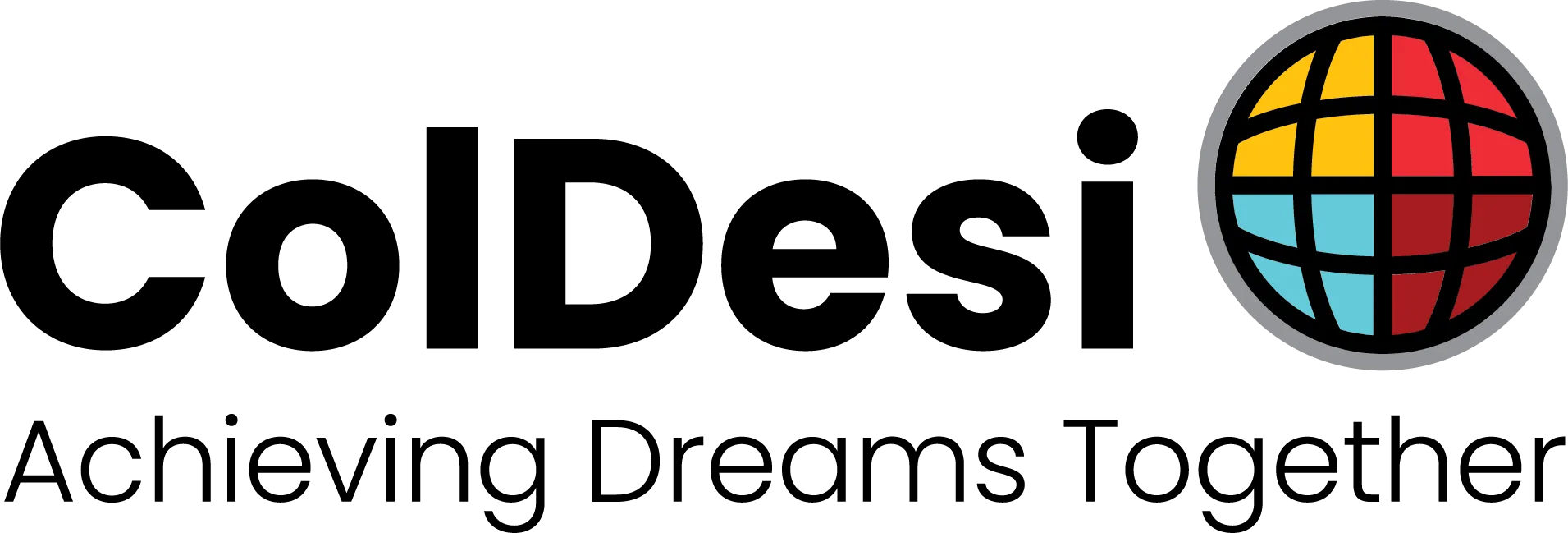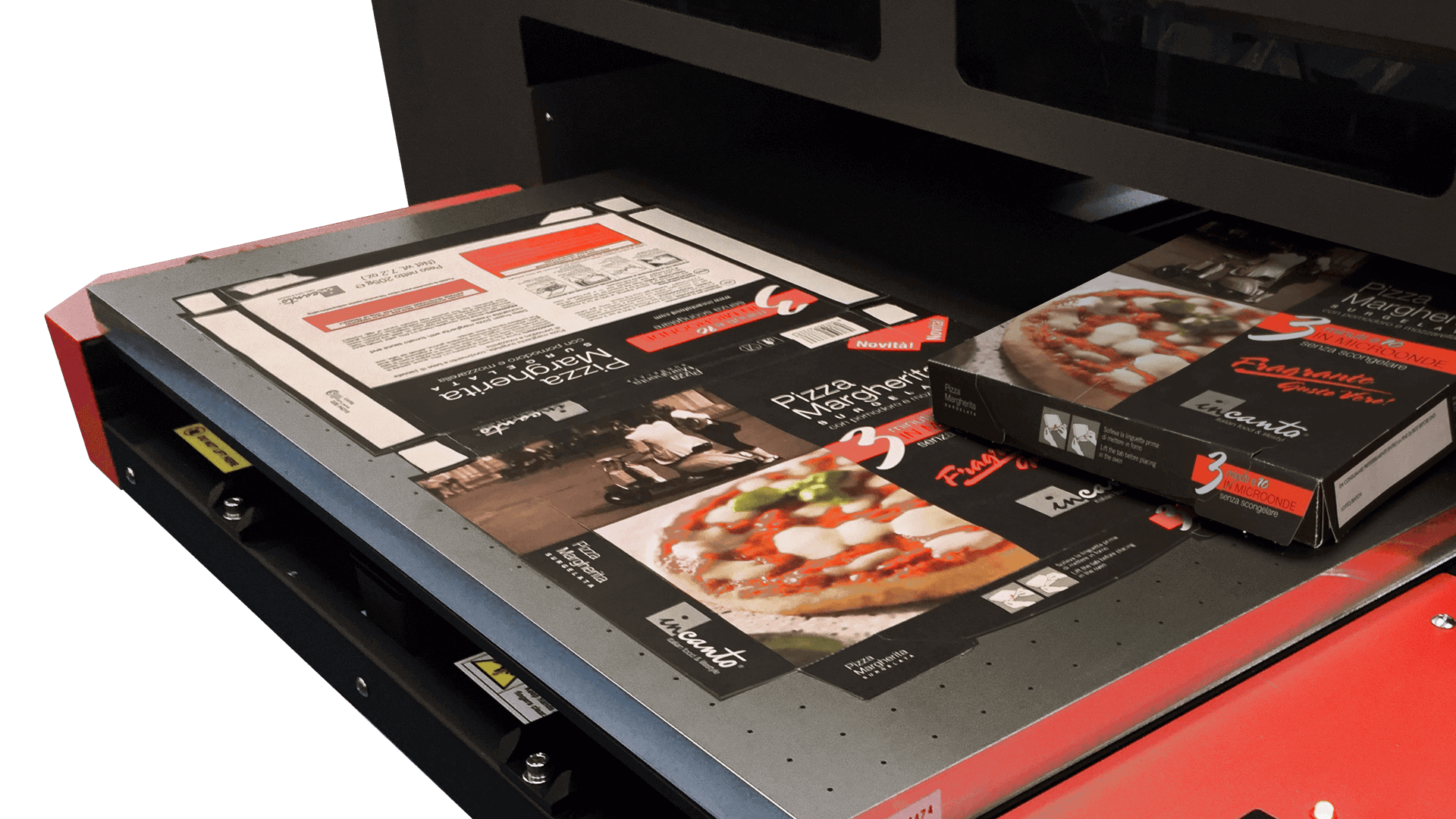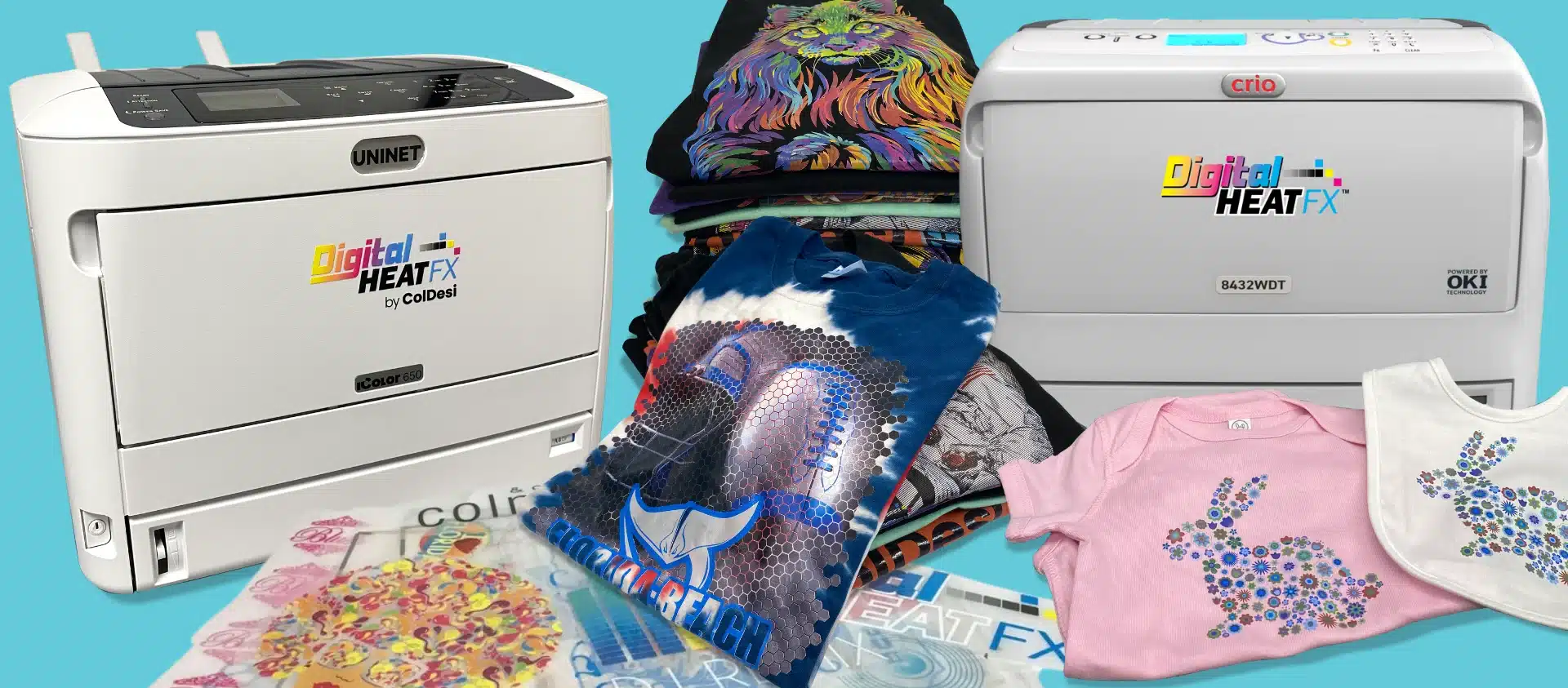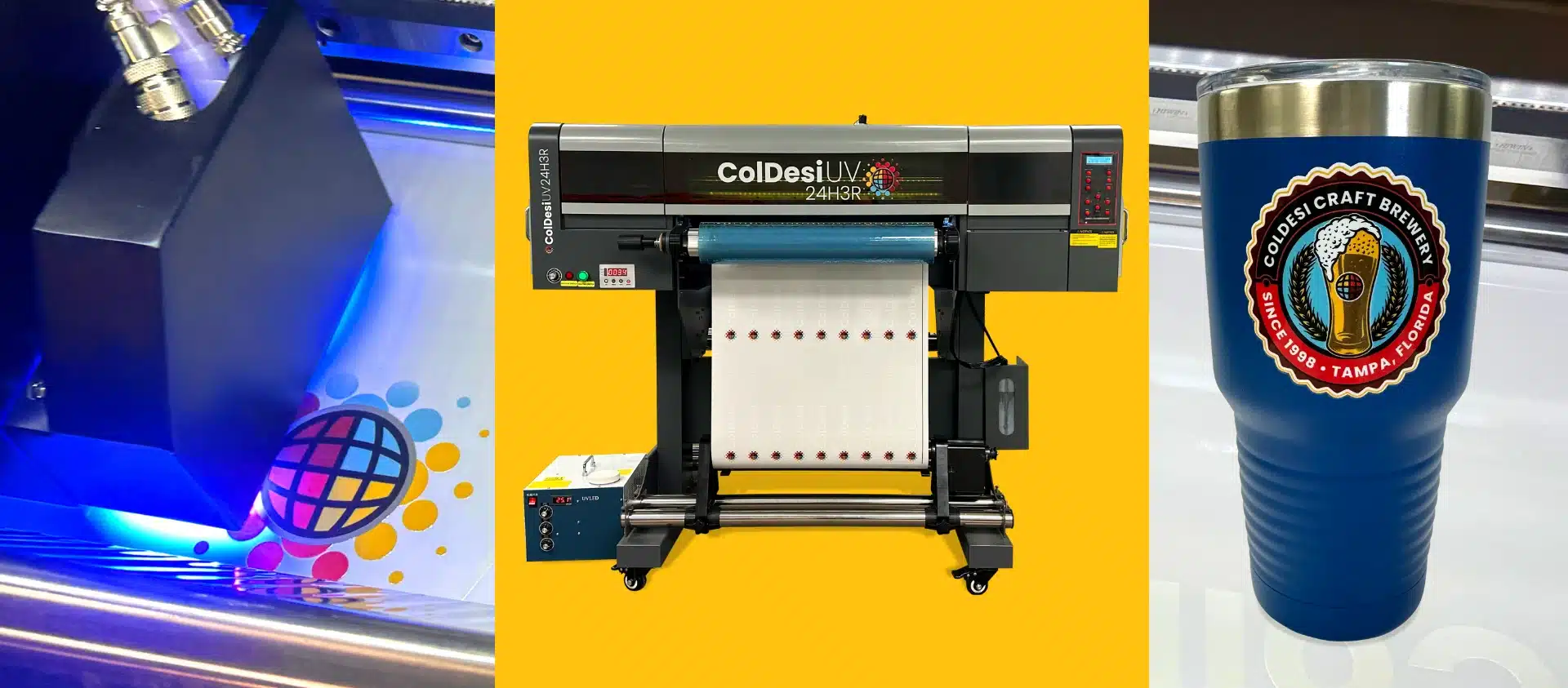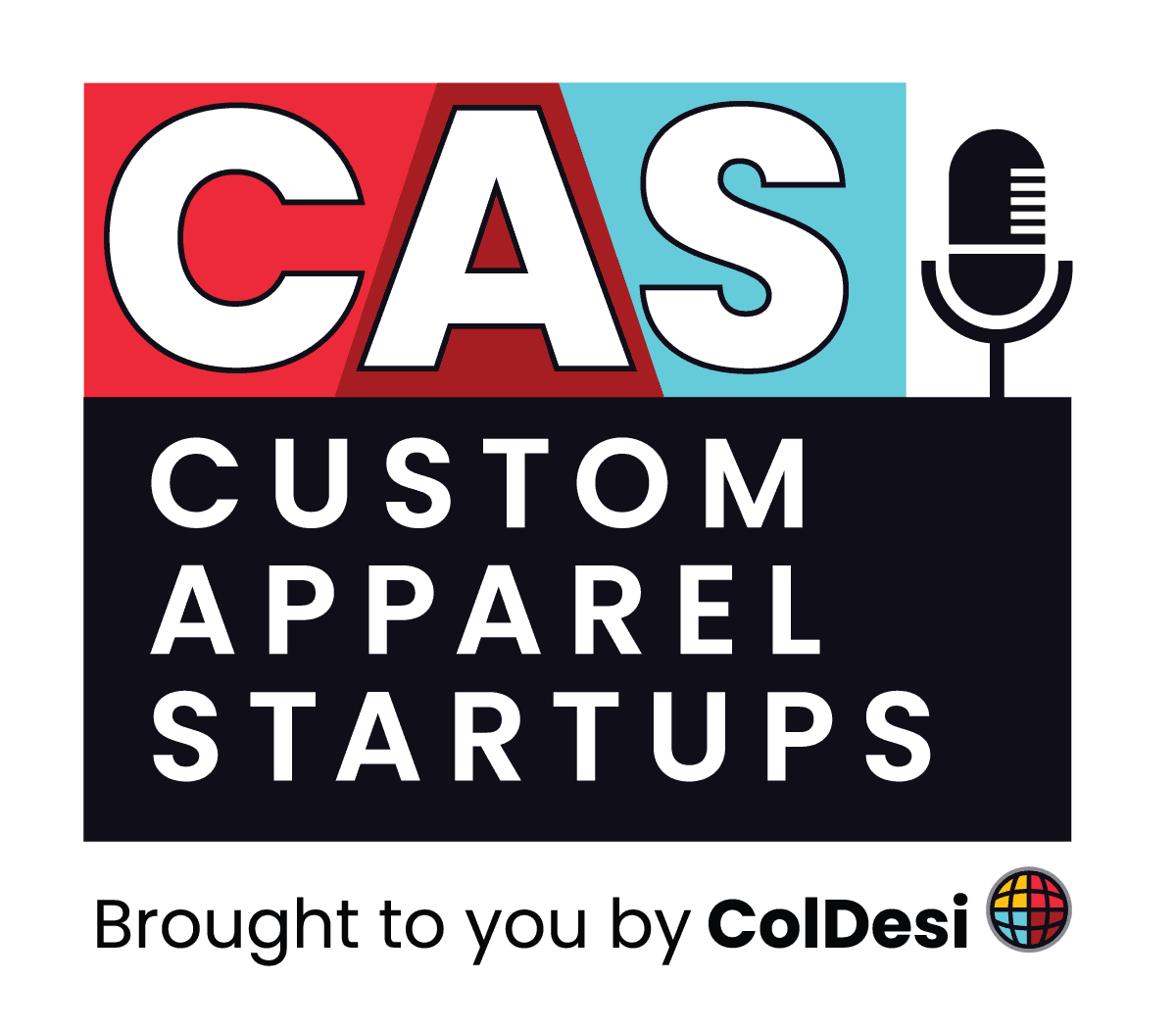
Episode 53 – Is UV Printing Right for Your Custom Apparel Business?
To discuss whether UV printing is right for your custom apparel business, we chatted with Don Copeland. Don was previously the Direct to Garments Product manager here at ColDesi, and since then has gone to launch a new (to the USA) product called the Compress UV Printer. We want to talk about what UV is and is it right for your business. What is UV printing?
Oftentimes you’ll hear it referred to as UV LED Flatbed printing. Mainly focusing on small to mid-format. Anywhere from 12×11 up to 48×30. I think a lot of people associate UV printers with the really large printers, and we’ve seen some at shows which are 4×8 feet and take up the whole building.
What does it mean to UV print something?
When you use UV printing you are using inks that are reactive to UV light. Those UV lights actually cure the inks, setting the inks on the substrate. We’re so used to a DTG printer that when a shirt comes out of the machine we don’t want to touch it, because it’s still wet. But with UV, it’s dry. Secondarily, it’s generally going on to items we historically wouldn’t do, like textiles – plastics, metals, woods.
UV printing is a combination of light and ink that reacts to it, so that it dries immediately.
Not just dries, it actually sets, there’s an actual reaction as well. Similar to DTG, we heat press the shirt, that’s not just drying the ink. It’s actually making a chemical reaction occur that sets the ink as well.
If you’re already an apparel decorator and you’re doing any kind of printing – sublimation, screenprinting, DTG – you have to do something after it comes out of the machine in order to set the ink. You have to throw it onto a drier or heat press.
When we first started delving into this, you didn’t want to touch it, because we’re so used to there having to be another step. With UV printing, it’s done when it comes out of the machine. That doesn’t mean there aren’t things you need to do ahead of time. There are certain substrates that aren’t receptive to the inks that you do need to treat. There are primers you can use that will make the surfaces more receptive to the ink.
Like a pretreat for DTG? But less involved?
A lot less involved. It’s a wipe on, air dry, and you’re done.
What do people do with UV printers? How do they make money?
That’s a really broad question, especially in today’s marketplace. In terms of the customer base we’d be talking to, they’d be ad specialties. If you look around your desk right now, anything that has something with somebody’s company name on it – whether it’s a pen, calculator, etc – all of those types of things are going to be one category of ad specialties. [Video example below}
Other applications would be trophies and awards – acrylic is huge. Acrylic has been historically done with either rotary engraving or laser etching. Now we can bring the aspect of color to that because we can print full color on acrylic, back print it with white, so you have a beautiful award that you’re looking through the acrylic. You can’t get that with traditional sublimation or traditional engraving and laser which are one color.
Other applications would be for signage. If you’ve got a business you’re doing t-shirts for with your apparel business, how cool would it be for a yard maintenance company, if he had yard signs that he could stick in the yard while they’re working. Great for realtors, people who sponsor events. A customer might to DTG towels for a golf tournament, and there’s 18 holes that they have sponsored that need signs. Or perhaps printed on golf balls. All these are complimentary items that your customers are probably going to someone else to have it done. The reality is you should just be their graphics department.
Another growth point for custom apparel is if you do t-shirts in embroidery, the next thing you get asked about is promotional products. People will typically join the various organizations that are out there so they can buy promotion products, and from our experience and the experiences of our customers, doing those on small to medium runs is not always easy. Finding a good quality product and then getting the image you want on there gets complex. If you’re screenpriting it you’re limited in colors, and a lot of customers will just not do that, and they run the risk of one, not making the money they could have, and two, of their customer going to another place that can do the promotional products as well as apparel.
The UV printers are not inexpensive pieces of equipment. They’re a commercial piece of equipment and they are an investment. But just in that scenario we were talking about in a recent webinar about bundling the embroidery machine and the vinyl cutter, someone comes in and they want to get an embroidered polo and hat set, for a school event, and they want to get the t-shirts done for the kids on the field and fan shirts. That’s a great bundle and you’re talking about turning a $15 cap sale into a $100 family support bundle. Think about adding a sign that family members could put in their yard on game day. The school might want to advertise with signs. Or have giveaways. You have the opportunity to corner that business.
Could you print on something like a baseball bat?
You could print on a bat, you could print on baseballs. We’ve printed on golf balls, basketballs. It opens up a lot of categories. If you’re doing the shirts for the state championship team, why not offer to do a basketball for them to put in the gymnasium with the year, school logo, maybe the final score of the game.
Or all the basketballs at a school, or all the baseballs. We’ve seen the Compress UV Printer work before, and it’s amazingly fast. This means it’s not going to take you two weeks to do a set of 36 baseballs.
It’s one of the things that I think that sets us apart in the marketplace, is that we’re able to print bidirectionally and get really good quality. In fact most of what we print is what we would consider a production mode. Historically when people requested samples on anything you generally go into art mode and you try to print the highest quality. We found that with DTG most people, two months in are printing in production mode anyways. The beautiful thing with the Compress is it’s very hard to discern between the production mode printing and the fine art mode. Until you start getting into the 1-2mm lettering on a golf ball, you don’t need to go into art mode. When you’re printing on 95% of items, you can go into production mode 720×720 bidirectional printing allows you to fly through, get a lot done. With the curvature of a basketball you’re going to slow it down, but when you’re doing traditional ad specialties (flat stock items), you’re going to fly through those in production mode. And because of the size of the bed on the machine, it’s going to allow you to load up a lot more.
Very similar to the DTG printers, it’s about interface time. You’re spending less time involved with the machine, producing. We have a customer who’s doing 60 4″x4″ tiles at a time. For a 3,500 piece order they were able to have 4 of those rows unloaded and reloaded while the printer was still printing.
Having seen the photographic quality, it’s very similar to DTG, if not better.
Probably better because you have no dot gain, because the ink is instantly set upon contact. So you don’t have any spread of the dot. When you print on a textile, even onto a polyester, you’ll have some level of dot gain which means you’re going to lose some detail.
Back to that bundling opportunity, the headshots of all the baseball kids, you can print those onto the backs of plexi and put that in the hallway outside the gym. There is so much possibility and because of that, profitability, because no one else has the ability to offer that.
UV Printing is about being smarter than the item you’re printing on. You’re dealing with dimensional items. It’s about being creative. We have Play-dough and Lego in our shop because we often have items that we need to prop up and hold in place. So we can nail the printing.
How much would something like that custom basketball cost?
The ink, when you’re talking about UV printing, doesn’t even come into the conversation. It’s so little. We recently did a demo for a company that does a lot of Christmas ornaments. They had an ornament that is a Scout uniform, and they customize them with a name across the uniform and were doing that by hand. They’re paying $1.25-1.50 a piece to have names put on them, and a 48 turn around time. We set it up, printed a name – 0.8 cents worth of ink. Just that one item alone during their Christmas season, they do 1,500-2,000 of them. They’re going to pay for 8-10% of their machine just in savings from that one application.
That’s also a great idea for promotional products – Christmas ornaments. Don’t think about it just as something externally you sell, you can also use it internally. Maybe you want to print your own boxes.
We did that with a customer who does a product made out of wood. It goes into a box, and we were able to reproduce their design on the product and then exactly print the same design on their box. Because of the depth of the machine, we were able to turn the boxes on the side, and print their information on the side – their website, anything they wanted.
You don’t have to worry about having a huge inventory of preprinted boxes. Let’s say someone wanted to buy 24 of these items, and give them to their employees, you can go to the box print the name of the manufacturer, with a personalized message – Happy Holidays, Merry Christmas, from XXXXXX. It’s taking the whole customization to a whole new level.
You can create prototypes for people. Even hang tags, if you’re exhibiting at an event, you can do custom hang tags.
What we try to do with our blog posts is bring people good marketing and business advice. Like our webinar where we talk about bundling the embroidery machine and the vinyl cutter together, you’re addressing a customer when they come in and selling them more. Normally the most expensive part of the process is getting that customer in the door. Now you’re not only doing more with that one individual, you’re backing into the sign and promotional product business as well.
When we think about this type of business in conjunction with what we do, the customization business is something that continually seems to be growing. People want the ability to customize everything. Which is why small show embroiderers and small shop t-shirt companies are doing so well. This UV printer allows you to take that small customization business and really think huge with it.
People are now in the graphics business, not just the t-shirt business, or the custom apparel business. When you add a UV printer to your repertoire you really are now int he graphics business. whether you want to take that image and put it on a hat or t-shirt, or as a sign or award.
I’ve used this analogy before in that we’re a “Walmart society.” What I mean by that is we go to Walmart to get some toilet paper, and a chicken, you’re also getting your cellphone recharged, you can grab lunch at McDonald’s. It’s all there. Did you really want to eat at McDonald’s, maybe not, but you were already there. Make it as easy as possible for customers to give you as much of their business as possible.
As you grow your business and perhaps start to do yard signs in full color, you’re going to start to get known for that. People will start to come to you for that product and will need whatever else you offer as well – whether it’s bling t-shirts for their kids cheer leading team, embroidery, etc. It’s all about creating new entry ways. It’s not only about getting your existing customers to spend more money with you, but getting new customers, and offering them the other products you already produce.
Let’s talk a little bit about the two questions that everyone’s going to have. First one would be “Can I use it to print t-shirts?”
Can you? Maybe. Would I suggest it? No.
There’s some talk that you can, and you don’t need a pretreatment. While that may be true, it opens a whole other can of worms. The inks that are used in all UV printing, are fairly similar. The concern with UV inks is that they contain monomers, and monomers are what actually make it set. If those monomers are not fully set, you run the risk of people having skin irritation. And that’s certainly something that;s a bigger concern with youth and children’s shirts. You need a flexible UV ink. Generally flexible UV inks work well on items that flex, however they don’t work well on items that don’t flex. So if you buy a printer based on doing t-shirts, you’ve got to choose – do you want to do flexible or rigid? It’s not something you’re going to switch between. Swapping out inks is a major expense, a major time waste.
And it to do it right you need a print area that’s indicative of a t-shirt. Most companies that are doing this are smaller format – 10×12″, 10×24″ – which don’t lend themselves to t-shirt size graphics. You’re spending $80-85,000 on a printer that’s meant to do rigid goods. If a company wants to do t-shirts and ad specialties, generally I find we can sell them a Compress 600, and a DTG M2, than less than a “universal type printer” that prints on t-shirts as well.
The other thing is that it doesn’t look good on t-shirts, and certainly doesn’t look good on cotton.
If you want to get a UV printer, it has to be kept in a ventilated area. This is not a back bedroom business. It’s a big machine, and the UV ink smell affects people differently. If you’re going to be working around it all day, especially if you’re overly sensitive to smells, you need to make sure it’s ventilated.
The inks we use are relatively low VOC. Most flexible inks are very high VOC. They certainly need a specialized ventilation system. We had someone getting headaches and couldn’t physically be in the room with the printer while we were trying to film stuff. Now with the lower VOC ink, they can be in the room for a few hours.
The other question is, how much is it?
We offer two models, 600 and 1200. They correspond to a 24 x 17.7″ print area on the 600 and 45.3 x 29.5″ print area on the 1200. Certainly the 1200 is not something you would want to use for a home business – it’s a beast. They come fully assembled, they are floor based. The 600 machine, you’re looking at about $37,000. That includes 5 litres of ink, cleaning solution, we include a rip software, as well as a design front end. Because you can print textures – raised lettering, highlighting. We also include a silicon pad that goes down on the bed that allows you to do targeting, and a sticky factor that allows your items to stay snug to it.
And we do an onsite install and training, where we come in, teach you how to operate the machine, how to work with the software, and to deal with the items. That’s really the key. We try to bridge that gap of you not being smarter than the items.
We then have the 1200, that machine is about $52,000. Same things included. It sounds crazy with the price differential, but in most cases we almost triple the amount of things we can output on the larger bed. If I was doing 8.5 x 11″ plaques, I could get 4 of them on the 600, I can get 13 of them on the 1200.
This is one of those next level business investments. If you’re just starting up your embroidery business, this should not be on the table for a little bit, but you could put it on your dream list.
If you’ve got an existing business, and you’re already looking for ways to expand, you always have this angles – do I want to stay in apparel, do I just need a second single head, etc. You’ve got to weigh all those things in. But if you’re starting to see a lot of demand from businesses, schools, etc that need and are spending a lot of money on ad specialties, or signage, then you start to look at UV printing as an angle to go. You may already have a customer that you’re farming stuff out to that you want to bring that in house.
This could be the right move for you. Everyone’s different and where they want to invest. All of the cost of these types of equipment come with the potential of them as well. A small vinyl cutter that you can get for $1,000 has some awesome potential, but a large UV printer comes with this whole new level. It’s a whole new level of investment, but also a whole new level of returns. You’ve got to figure out for your small business, what is the direction you want to go, what’s your potential business, how much do you want to make? Have a look in your area, in your niche, what is your competition?
If you’re already a large screen printing or DTG shop, just start asking your customers. Tell them you’re thinking about adding this capability, and some of their eyes may light up and they’ll be excited to do business with you on this stuff too.
There’s a bell curve we go through on new technology, especially digital technologies. You have the early adopters/pioneers. They’re ones who excel at it, and make really good money off it, because there’s not a lot of competition. As you start up the curve, the technology grows and it gets a little more friendly, a little more affordable, but adopters are still in a good place. Then you hit that peak, where it’s something that you’re making decent money on, but in the near future, it’s going to start going back down that bell curve, where if you’re in the sign industry, if you don’t have a large format printer, you’re not in the sign industry. That’s a have to have.
We’re just ascending the bell curve where the printers and inks are really good, and they’re reasonably affordable, but not many people are providing this service yet.
This UV industry is still fresh and new. You could do a Google search and probably not find anyone at all who’s doing it.
You might have a company looking to print on a widget. They’re going to search for “How do I print on poly-carbonate?” You have all kinds of opportunities from manufacturers, to take and decorate their item that really makes them look custom or for safety purposes (they can’t have something that peels off).
The Compress UV printer is unique to the market place. We encourage everyone to visit coldesi-uvprinter.com and check it out, and perhaps give Don a call and talk about what you want to accomplish. You’ll get real answers to your questions and really solutions to your problems.
Have a good business!
- Join us on Facebook: Custom Apparel Startups
- Listen to more postcasts: caspodcast.com
- Watch some sales and business webinars: caswebinars.com
- Learn more about Rhinestone Machines, Embroidery machines, Direct to Garment Printing and more at coldesi.com
